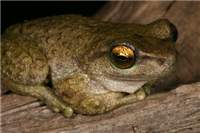Family
HylidaeGenus
LitoriaSpecies
spenceri
Threats/Control Methods - Regional
The aforementioned introduced fish species are known to predate on tadpoles and it is thought this may have negatively affected L. spenceri population numbers. Habitats change and disease, such as the Chytrid Fungus are also thought to pose risk to the species.
For more information on the Chytrid fungus © Link to fact sheet http://www.deh.gov.au/biodiversity/invasive/publications/c-disease/
Frogs drink and breathe through their skin and are very sensitive to chemicals in their environment. Where possible, you should not handle frogs, as the natural bacteria on your hands or chemicals such as sunscreen can damage their skin and cause illness or death.
Local/Urban Actions
The University of Canberra is involved in a Recovery Team for the species, other members include other Universities, NSW Parks and Wildlife Service, Environment Australia and other conservation groups.
Frog monitoring, under the Frogwatch Program, is run annually within the ACT, with monitoring done by volunteers from the general public over a two week period. The Frogwatch program provides training for community volunteers each October.For more information on Frogwatch contact:The ACT Frogwatch Coordinator, Ginninderra Catchment Group; Ph(02)62783309 oremail: [email protected]
Although it is unlikely that this species will be attracted to the urban backyard it is possible to attract other frog species. Urban backyards can become suitable habitats for frogs through simple landscaping techniques. The Australian National University and the Ginninderra Catchment Group have developed a guideline to help you encourage frogs into your backyard called [Link - Creating a Frog Friendly Habitat in the ACT Community]
Distinguishing Features
The body is mottled with creamy yellow and olive green, measuring 5- 6cm in size. The skin has a rough wart-like texture. This species does not call very loudly, calls being described as ©warrrk©cruk..cruk..cruk..cruk©
Common name/s
Spotted Tree Frog
Similar Species
Booroolong Frog (Litoria booroolongensis ), Tablelands Bell Frog (Litoria castenea ), Rocky Stream Frog (Litoria lesueuri ), Southern Leaf-Green Tree Frog (Litoria nudidigitus ), Peron©s Tree Frog (Litoria peronii ), Whistling Tree Frog (Litoria verreauxii verreauxii ), Green and Golden Bell Frog (Ltioria auera), Broad-palmed Frog (Litoria latopalmata ), Southern Bell Frog (Litoria raniformis ).
Distribution
Currently only a small number of populations exist, the numver of populations thought to be below 15, all occurring on the North-West side of the great dividing range.
Country of Origin
Australia
Survey Techniques
Although a quiet caller, call identification remains the easiest and safest way to detect the species.
Conservation (Pet/Pest) Status - National
Listed as a threatened taxon on Schedule 2 of the Flora and Fauna Guarantee Act 1988, Endangered (Schedule 1 of Endangered Species Protection Act 1992); Threatened (Schedule 1 of Flora and Fauna Guarantee Act 1988).
Conservation (Pet/Pest) Status - Regional
Endangered (Schedule 1 of NSW Threatened Species Conservation Act 1995); Vulnerable (ANZECC 1995).
LSCCES Population
No habitats thought to occur within the ACT, although populations are thought to exist within Bogong Creek, Kosciusko NSW.
Associated Vegetation Community
Rocky habitats near fast moving water.
Limiting Resources
Naturally occurs at elevations from 200-1100meters above sea level. The species seems to require rocky streams with streamside vegetation. The species only breeds in permanent water bodies, such as connected pools, with slow moving water.
Rocky shallow pools are required for egg laying and there have been indications that successful breeding only occurs in summers with low flow events (see Gillespie, G.2002 p189 for more information.)
Breeding
Breeding occurs in spring, and once hatched tadpoles use rocks and pebbles as shelter to hide from predators.
Behaviour
This species is know to bask in the sun during the day, and will quickly jump into fast moving water to avoid terrestrial predators.
Functional Group
Insectivore
Food Species
Small invertebrates.
Predators
Introduced fish including the Rainbow Trout (Onchorhychus mykiss) and the Brown Trout (Salmo trutta).
Interesting Fact
The oldest known member of L. spenceri was an 13 year old female, while the average life-span of the species is 8-9 years, depending on the region the individual is from.
References - (reader suitability of references, P=Primary teachers, S=Secondary students, T=Tertiary students and researchers)
Journals:
Gillespie, G. (2001) The role of introduced trout in the decline of the spotted tree frog (Litoria spenceri) in south-eastern Australia. Biological Conservation.100:187-198. T
Gillespie, G.(2002.). Impacts of sediment loads, tadpole density, and food type on the growth and development of tadpoles of the spotted tree frog Litoria spenceri: an in-stream experiment. Biological Conservation. 106:141-150. T
Online Publications:
Department of Environment and Heritage. Spotted Tree Frog 1998-2002 Recovery Plan. Accessed 1 July 2006. Available online:
http://www.deh.gov.au/biodiversity/threatened/publications/recovery/spotted-tree-frog/index.html S, T
Researcher: Pippa Jaminon

 Top
Top Top
Top